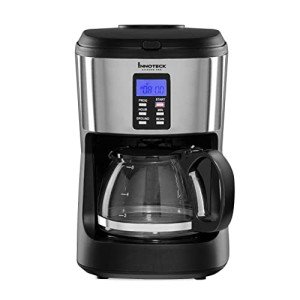The 10 Most Scariest Things About Espresso Machines

A Comprehensive Guide to Espresso Machines: Types, Features, and FAQs
Espresso machines have ended up being a staple in coffee culture, captivating both lovers and casual drinkers alike. As the need for high-quality coffee boosts, comprehending the variety of espresso machines offered and their functions becomes crucial. This post aims to supply an extensive exploration of espresso machines, covering their types, performances, and what to consider when purchasing one.
Types of Espresso Machines
Espresso machines been available in several designs, each with unique functions, advantages, and compatibility with various brewing methods. Listed below, we talk about the main types of espresso machines readily available on the market:
| Type | Description | Target User |
|---|---|---|
| Manual Espresso Machines | These need the user to physically run the machine, using complete control over the developing procedure. | Coffee purists and lovers |
| Semi-Automatic Machines | These machines automate the water pressure but require manual input for brewing time. | Intermediate users |
| Completely Automatic Machines | These machines do everything immediately, from grinding the beans to brewing the coffee. | Busy specialists |
| Super-Automatic Machines | These machines are totally automated and can produce various coffee drinks with very little user intervention. | Users seeking convenience |
| Capsule Espresso Machines | These utilize pre-packaged coffee pills to streamline the developing procedure. | Casual drinkers |
| Commercial Espresso Machines | Durable machines designed for high-volume use, usually discovered in cafes and restaurants. | Cafe owners and enthusiasts |
1. Handbook Espresso Machines
Manual espresso machines use unequaled personalization for coffee lovers who value the art of developing. Users need to practice methods such as tamping and pump pressure to develop the best shot of espresso.
2. Semi-Automatic Machines
These machines strike a balance in between user control and automation. They automate water flow but need the barista to control the brewing time. Semi-automatics are popular among home baristas who wish to refine their skills without the intricacy of completely manual machines.
3. Completely Automatic Machines
Totally automatic machines eliminate much of the uncertainty included in developing. They grind, dose, and extract espresso with one touch of a button, making them ideal for users who value speed and consistency.
4. Super-Automatic Machines
Super-automatic machines take convenience to the next level. They can prepare a remarkable selection of beverages, from espresso to cappuccino, with little to no user input, making them perfect for busy households or offices.
5. Capsule Espresso Machines
Pill machines, such as those from Nespresso or Keurig, use pre-packaged pods that simplify the brewing procedure. While they provide convenience, the variety of taste and freshness might be limited compared to whole coffee beans.
6. Business Espresso Machines
Designed for heavy usage, commercial machines are built to produce high-quality espresso quickly and consistently. They often feature advanced technology like multi-boiler systems and integrated mills.
Features to Consider When Choosing an Espresso Machine
When picking an espresso machine, purchasers ought to think about numerous important aspects, as these will considerably affect the general developing experience and the quality of the coffee produced. Here are key functions to assess:
Boiler Type
- Single Boiler: Good for those who brew primarily espresso.
- Dual Boiler: Allows for brewing espresso and steaming milk all at once.
- Heat Exchanger: Provides high pressure for espresso while allowing steaming.
Mill
- Integrated Grinder: Offers convenience with integrated options for grinding coffee.
- Separate Grinder: Provides flexibility and the option to pick the grinder best fit to your tastes.
Portafilter Size
- Requirement: Usually 58mm, fits most machines and offers outstanding extraction.
- Smaller Sized Sizes: Often discovered in lower-end machines, which might affect taste.
Reduce of Use
- User-Friendly Controls: Essential for newbies or hectic individuals.
- Modification Features: Important for lovers who choose hands-on developing.
Cleaning up and Maintenance
- Removable Parts: Facilitate easy cleansing.
- Automatic Cleaning Systems: Helpful for keeping the machine's performance.
Size and Design
- Counter Space: Ensure the machine will fit in your cooking area.
- Aesthetic Appeal: Consider the machine's overall design to match your kitchen area design.
FAQs about Espresso Machines
What is the distinction between espresso and regular coffee?
Espresso is brewed by requiring hot water through finely-ground coffee under pressure, leading to a concentrated shot with an abundant flavor and crema. Highly recommended Reading is generally brewed using approaches like drip or pour-over, which utilize larger coffee premises and produce a lighter taste.
How do I preserve my espresso machine?
Routine upkeep includes descaling the machine, cleaning up the portafilter and group head, emptying the drip tray, and replacing any water filters. Automatic machines often have built-in cleaning programs.
Can I use regular coffee beans in an espresso machine?
While you can technically utilize regular coffee beans, espresso is best made with beans specifically roasted for espresso. These beans are generally darker and more oily, offering the rich taste and strong aroma that espresso is understood for.
How can I improve my espresso-making abilities?
Practice is crucial! Explore various grinds, tamping methods, and extraction times. Consider utilizing a scale to determine coffee and water specifically. Seeing tutorials online can also provide insights into innovative methods.
What is the average rate variety for a good espresso machine?
Prices can vary substantially based on type and functions. Fundamental manual machines start around ₤ 100, while high-end super-automatic machines can cost over ₤ 2,000. Semi-automatic machines normally range from ₤ 300 to ₤ 1,500.
Espresso machines use a broad spectrum of choices, each dealing with different preferences, experiences, and budgets. Knowing the varieties readily available and the necessary features can assist consumers make informed choices that cause delicious, café-quality espresso in the convenience of their homes. Whether one looks for to delight in abundant tastes or requires a hassle-free developing option, an espresso machine can elevate the coffee experience beyond the everyday cup.

